An explosion is defined as “a rapid increase in volume and release of energy in an extreme manner,” and is usually accompanied by high temperature generation and gas release. Flammable gases, vapors, dusts and ambient oxygen — all present in chemical processing facilities — can react to cause an explosion that essentially creates a shock wave.
As a result of modern production technologies and increased production capacity, an explosion is a threat chemical processors confront daily, says Gerd Mayer, president of Rembe (Charlotte, N.C.; www.rembe.com).
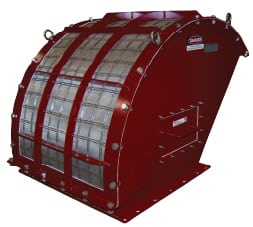 |
| Fike |
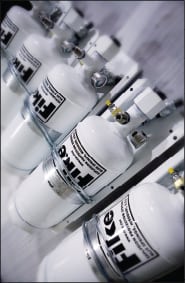 |
| Fike |
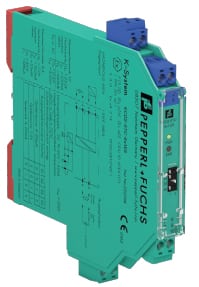 |
|
Pepperl+Fuchs
|
While there are Occupational Safety and Health Admin. (OSHA; Washington, D.C.; www.osha.gov) standards and industry guidelines — namely OSHA’s Combustible Dust National Emphasis Program and NFPA’s 654, 68 and 69 — chemical processors are still often confused when it comes to selecting and installing explosion protection systems.
Designed for use with square or rectangular explosion vents, FlamQuench SQ technology consists of various layers of high temperature stainless steel that absorb heat produced during combustion. This allows conventional venting to be done indoors with no release of flame
“Protection is very different than prevention,” explains Vahid Ebadat, CEO of Chilworth North America (Princeton, N.J.; www.chilworth.com). “When it comes to explosion protection, what you’re saying is that you are anticipating that an explosion will occur, but you have designed your processes and equipment in such a way that when an explosion does occur, people won’t be harmed and the facility won’t be damaged.”
And, he continues, in order to do this, operators need to have a clear understanding of their operations and processes, as well as the chemicals being used and the associated risks they create. “Knowledge of the maximum pressure and the severity of the explosion that could occur as a result of ignition of the flammable gas, vapor or dust cloud atmosphere is imperative,” he says.
In addition, the objectives of the facility owners must be evaluated, says Bruce McLelland, national accounts sales manager for explosion protection with Fike Corp. (Blue Springs, Mo.; www.fike.com), such as how much damage is tolerable and what kind of changes the facility owner is willing to make for protection. “Is it acceptable if, at the end of an event, a vent has worked properly and protected against the worst case scenario, but the processing equipment is destroyed by fire after the explosion?” he asks. “It’s good that there wasn’t flying debris or injuries or loss of facility, but there is still a loss of equipment and there will be a significant loss in process downtime. Processors need to look at all types of available explosion protection equipment and determine what is acceptable loss to them.”
Mayer agrees. He suggests considering three basic requirements when selecting a solution: profitability (the protection solution has to be economical to implement, operate and maintain), reliability (the protected facility has to remain permanently and optimally available for production) and safety (people and machines must be ensured of an explosion-protected environment through constructive and effective directives).
Equipment types
In addition to the use of appropriately rated electrical equipment and intrinsically safe instruments and devices in hazardous areas, there are three main types of explosion protection solutions, each with its own set of pros and cons. Solutions include the following:
Containment. Process equipment can be designed to withstand the maximum explosion pressure. However, containment can be an expensive option because of the special engineering and strength required. Often, once the equipment is built, access to the vessel for routine maintenance is cumbersome. And, it is necessary to maintain the pressure integrity of the vessel for life. Corrosion or other wear and tear can weaken the equipment over time. In practice, this option is usually considered for small vessels or where highly toxic chemicals must not be released.
Explosion suppression. Like a fast-acting fire extinguisher, suppression systems kick in when an explosion starts to develop. When explosion conditions are detected, a suppressant is injected into the dust or vapor cloud to quench and stop an explosion. While this is a viable solution, it can be an expensive option because detectors and sensors, control systems and battery backup equipment are required and must be regularly maintained.
Explosion relief venting. Compared to the first two options, venting is usually the simplest solution. It consists of a panel or door that will rupture or open and release the explosion products (pressure and flame). The problem here, however, is that vents can’t normally open inside a building and must be routed to a safe location outside the building, which requires proximity to an outside wall. And, it is not an option when the chemical being released could cause an environmental hazard.
There have been some advances in explosion protection solutions, including suppression systems that offer optical detection to improve the speed of response and stability of detection, and indoor venting systems, referred to as particulate retention and flame-arresting devices, that, under some circumstances, make venting possible when equipment has no easy access to an outside wall. And, these can all be used in conjunction with intrinsically safe instrumentation, the use of which helps reduce — but not always eliminate — the need for explosion protection equipment in some installations, says Robert Schosker, product manager of intrinsic safety with Pepperl+Fuchs Inc. (Twinsburg, Ohio; www.pepperl-fuchs.us).
However, experts agree that what might seem like the best solution may not actually provide the best protection for a given facility. It is highly recommended that chemical processors seek a risk assessment that can classify the hazardous areas, determine the risks and, based upon that information, select the explosion protection solution or solutions that will protect employees, equipment and processes in accordance with the facility owner’s objectives.
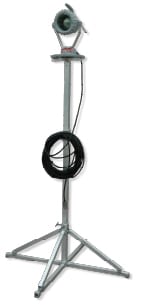 |
|
Larson Electronics
|
“Ultimately, the best solution is the one that provides life safety and enables the facility to maintain their business with the least interruption possible,” says McLelland.â
Explosion-Related Products
Install these lights in hazardous environments
The portable tower and removable lamp assembly design of the EPL-QP-1X150-100 explosion-proof halogen light tower (photo, above) provides 1,500 ft2 of work area coverage with 1,520 lumens of light output. It is designed to provide operators in hazardous locations with a powerful portable lighting solution. Equipped with a 150-W halogen bulb that produces illumination in a wide flood pattern, the explosion-proof lamp housing is suitable for wet areas. — Larson Electronics LLC, Kemp, Tex.
Verify grounding with this system
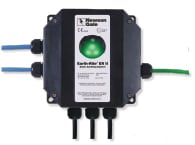 |
|
Newson Gale
|
The Earth-Rite static electricity monitoring system provides a margin of safety when Type C FIBCs or similar static dissipative containers are used to transfer bulk powdered and other solid materials in hazardous-area applications. The system includes an enclosed, intrinsically safe power supply and an electronic monitor. It continuously verifies the existence of a low-resistance path between the container’s static dissipative or conductive fibers and a known grounding point, typically through a mechanical grounding clamp affixed to a flexible tab. — Newson Gale Inc., Jackson, N.J.
An explosion vent with extended life
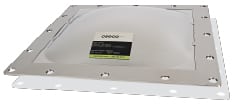 |
|
Oseco
|
The MV-RD explosion vent (photo) provides extended in-service life and lower burst pressure in smaller sizes. The vent is designed for high cycling applications, such as in dust collectors and baghouses that experience vacuum pressures up to 12 psig (24.4 in. Hg). The vent mounts on enclosures where dust explosions may occur, and will activate to safely relieve pressure in the event of deflagration, preventing a large explosion. It can also be used on bulk storage units and in ductwork applications requiring a square explosion vent. The vent features a high vacuum rating to help extend the life of the vent in applications where high vacuum pressure exists. Its lower burst pressures provide users with the ability to get the required relief area without having to use a larger vent size. It can operate in temperatures up to 450F and meets OSHA’s Combustible Dust National Emphasis Program and NFPA 68. — Oseco, Broken Arrow, Okla.
This suppression system meets NEP requirements
 |
|
BS&B Safety Systems,
|
Type IPD chemical isolation and suppression system (photo) provides explosion protection for facilities handling combustible powders. Installed, the system meets the requirements of OSHA Combustible Dust National Emphasis Program (NEP), as well as NFPA 654, 68 and 69. System components include a power supply and battery backup, a monitoring module indicating system status/drive external relays, a unitized sensor to detect explosion onset and suppression cannons that deliver a safe sodium bicarbonate suppression agent into the protected equipment. The cannon’s compact size and low mass simplify installation and allow the unit to be installed at any angle. There is no need for heavy extension piping and nozzles for suppressant dispersion. — BS&B Safety Systems, Tulsa, Okla
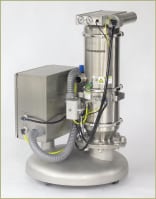 |
| Volkmann |
Vacuum conveying system
By using a sophisticated, nitrogen purging function, the INEX vacuum conveying system reduces oxygen content within the unloaded batch to below 7% (or lower when required), maintaining the material’s inert safety, while providing dust-free transport. The INEX features a closed station that can be flushed from within by sucking in the washing liquid, or through clean-in-place. Standard lightweight and pressure-rated systems are available with INEX functionality. — Volkmann, Inc., Hainesport, N.J.
This loop-powered indicator provides local data
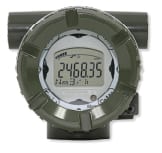 |
| Yokogawa |
The MLX loop-powered indicator (photo) incorporates the LCD from the company’s EJX pressure transmitter into a NEMA 4X aluminum housing. Typical applications for the FM-approved, loop-powered indicators are in potentially hazardous environments in the chemical industry. They provide an additional view of the measured value between a field instrument and the control room. This local indication of flow, pressure, liquid level or temperature can provide assistance during maintenance or when troubleshooting a malfunction. The MLX contains a six-digit numerical and alphanumeric displays for engineering units and a 20-segment bar graph indicating 0–100% of full scale. — Yokogawa Corp. of America, Newnan, Ga.
Backblast Dampers
This backblast damper, or backdraft damper, is a passive isolation device used to prevent a deflagration from propagating back upstream in ductwork in the event of a dust collector explosion. It is usually installed on the ductwork upstream of a dust collector. The unit contains a gate that is held open by the normal process airflow. Should a pressure wave from an explosion in the collector propagate through the ductwork in the reverse direction of the normal airflow, it will force the blade down to prevent the deflagration from passing further upstream. These dampers can be equipped with an explosion vent or hatch used to relieve the pressure at that point. Dampers without vents can be used in applications where the dust collector is properly vented. — Flamex, Inc., Greensboro, N.C.
Pressure Transmitter
The AST46HA Series of explosion-proof pressure transmitters offers extended pressure ranges, enhanced construction materials and new certifications to withstand hard conditions. With extended pressure ranges up to 20,000 psi, the transmitter addresses the need for a high pressure, high-cycle pressure transmitter and is constructed of very thick diaphragms and state-of-the-art silicon strain gages to offer repeatable results in hostile environments. In addition to Class 1, Div 1 Groups A, B, C, D approvals that make the transmitter suitable for use in acetylene and hydrogen environments, the unit possesses Class 2, Div 1, Group E, F and G (dust ignition proof) approvals, as well. — American Sensor Technology, Mt. Olive, N.J. www.astsensors.com